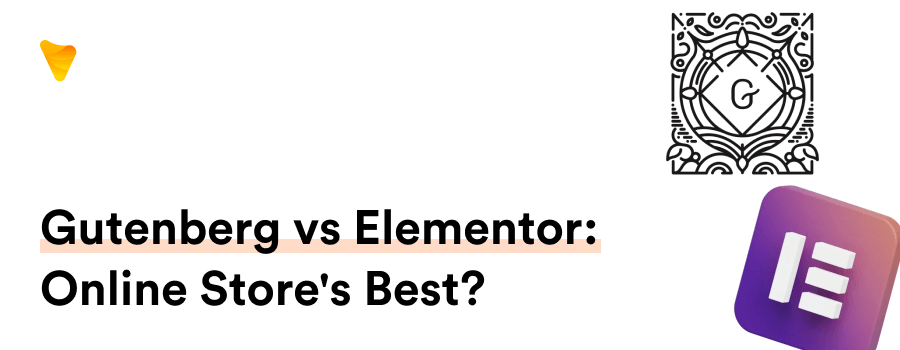
Gutenberg Vs Elementor: Which is Better for an Online Store?
Introduction
Digging Into the World of Website Building
Creating a website that stands out is a necessity in today’s crowded digital marketplace. With the advancement in technologies, building a well-structured webpage that enhances the browsing experience of users has become essential, and thankfully, not as arduous a task as before. Many builders are available to construct your vision into reality, including Gutenberg and Elementor. Elementor is a popular choice, with over 70+ advanced features, extensions, plugins, and widgets that can make your webpage incredibly lively and productive. It even offers HTML Code widgets for inserting any custom coding you may need through a webpage, offering full flexibility in design and function.
Behind the Curtain: What Are Gutenberg and Elementor?
Before we delve into a detailed comparison, let’s break down what Gutenberg and Elementor are. Gutenberg, introduced by WordPress in 2018, is a text-based block editor enabling you to seamlessly include various elements such as text, widgets, and custom posts in a single file. It negates the need for the “Classic” WordPress editor, lacking any drag-and-drop functionality, with a wide variety of Gutenberg block examples like paragraphs, headings, tables, images, and even videos. Most WordPress themes demonstrate excellent compatibility with Gutenberg. On the other hand, Elementor, is a dynamic page builder renowned for its drag-and-drop functionality and form builder prowess, all while offering interactive customization options for WordPress themes. It becomes a pleasure to build any type of form or website layout with the Elementor page builder and advanced customization options available.
The Tale of Gutenberg: Pros and Cons

An Overview of WordPress Block Editor – Gutenberg
Gutenberg is not just a mere editor. It’s a revolutionary block website builder that transformed the original WordPress project’s content creation process. First released with WordPress 5.0 in 2018, Gutenberg has been the default WordPress editor ever since, establishing itself as a vital plugin. It allows you to create and design content using its diverse custom blocks, which include paragraphs, images, videos, galleries, and files. Gutenberg’s popularity stems from its easily customizable blocks and user-friendly interface.
The Benefits and Limitations of Gutenberg
Gutenberg shines with its simplicity and easy-to-grasp block concept. It receives much praise in the shopping spotlightein for its sleek writing experience and efficient organization. There’s also the undeniable allure of it being completely free. However, the limited design capabilities and theme options can disappoint users seeking more intricate or customized designs. Moreover, we found some user reviews mention potential compatibility issues and a lack of top-notch customer support, which can be frustrating. While it’s fair to point these limitations out, keep in mind their relevance can vary depending upon the specific themes or plugins you are using. To get personal assistance, you can try reaching out via email with your queries.
The Story of Elementor: Strengths and Weaknesses

Introduction to Website Building with Elementor
Stepping into the Elementor world means entering an extensive realm of customization options. What sets this tool apart, much like the intuitive interface of the WordPress’ Gutenberg editor, is its drag-and-drop feature which gives you the freedom to design your site intuitively, seeing the result in real-time. Utilizing powerful plugins such as ShopEngine can further enhance your website’s functionality. Offering both free and pro versions, Elementor, along with ShopEngine, empowers you to create unique, stunning web designs without any coding experience. Don’t forget, this Halloween, enjoy up to 35% discount on ShopEngine Pro before the offer runs out. No need for a coupon code, just make sure to make your purchase between 25th Oct to 8th Nov.
The Advantages and Shortcomings of Elementor
Elementor, with its robust customizability and vast library of templates, can help transform your vision into reality effortlessly. The integration of clever addons for Elementor enhances this further. This compatible and fully responsive addons pack offers 25+ widgets taking full-fledged, handy integrations to another level. These ready-made designs cater to a diverse range of needs, even extending to each unique gadget. However, as Master Addons can powerfully enhance the functionality and appearance of web pages, robust server performance is key. Complex animations and large addons can affect the page loading speed, particularly if the server location is not optimized. Plus, you’ll need to opt for the paid version for full access to advanced features. Thankfully, deals like the Halloween offer provide a hefty 60% off, using the coupon code: SPOOKY60, from 25 October – 2 November.
Feature Face-Off: Gutenberg vs Elementor

User Interface and Ease of Use: Comparing Gutenberg and Elementor
Comparing usability, Gutenberg’s interface might seem more straightforward with its block layout. In appearance, Gutenberg is designed to be a wysiwyg editor, but it fails to deliver that full wysiwyg experience. Still, it’s friendly for beginners. On the other hand, Elementor, though more complex, is geared towards advanced customization. Once you login and pass the learning curve, it might be more fulfilling in terms of design capabilities. Consequently, your pick here would depend on your needs and preference. Additionally, platforms like Elementor give you outstanding options for user feedback which can be crucial for improving your website’s user interface.
Advanced Formatting: Elementor vs Gutenberg
When it comes to advanced formatting, Gutenberg requires you to insert custom CSS for essential personalization, enabling things like custom lists and unique photo styles. Elementor, on the other hand, stands out with its layout design capabilities and easy-to-use interface. This plugin brings all formatting styles right to your front panel, simplifying and accelerating the formatting process. It empowers you to manipulate elements such as style, background color, images, plus common customization options like typography, colors, padding, and spacing, in a more user-friendly manner.
Responsiveness: A Decisive Factor
Responsiveness, being crucial for any site, carries special weight in this Gutenberg-Elementor battle. Both these builders create mobile-friendly designs, but their approach to addressing any underlying queries can vary, especially in the United States. Gutenberg adapts to screen sizes independently, with no manual control essential – a seamless experiencecontinue for its users. Alternatively, Elementor gives you full reign over display settings for different screens, fitting the content appropriately and even allowing you to hide/display specific widgets on mobile and desktop views.
Performance Showdown: Gutenberg and Elementor
Speed and Impact on Page Load: Critical for Online Stores
Page speed is a make-or-break factor. The idea of website customization employs fast loading pages as it significantly impacts rankings, customer experience, and ultimately, sales. Our tests indicate a slight edge in favor of Gutenberg considering its more minimalistic nature that yields a faster loading time. Twitter, among other third-party services, also integrates well with Gutenberg, hinting at its flexibility. Conversely, Elementor, powered by a strong java backend, although faster than most other builders, lags a notch behind Gutenberg. Hence, if page loading speed is your top priority, Gutenberg might just be the winner for your website customization requirements.
Backend vs Frontend Editing: Analyzing Performance Factors
Editing efficiency plays a key role in website development. Gutenberg’s backend editing system, despite its design spec might make it hard for newbies to grasp, especially with no live preview of changes such as block alignment, block color, heading style, and yes, even width measurements. It’s more suited to experienced developers who can track these metrics while editing.
Contrarily, Elementor’s frontend editing interface shatters this barrier with live changes preview that means a more user-friendly experience. It’s easier to double-check the design and know exactly what the output would look like – you can adjust the critical elements like the height and width seamlessly. This not only enhances the visual appeal but also ensures better adherence to your desired design spec.
Key Features for Online Stores
Understanding Gutenberg’s E-commerce Capabilities
For online stores, Gutenberg’s block-based content creation serves quite well. Features like reusable blocks, the shortcode block, and oxygen make product listings easy. Plus, the editor allows the direct importing of product images, copying, and pasting product descriptions, as well as embedding shortcodes and links. It’s simple yet effective for e-commerce website creation. However, it may lack dedicated e-commerce blocks or templates comparable to builders like Elementor. Yet, consulting a comparison study such as Elementor vs Oxygen can give a broader understanding of its capabilities.
Elementor: Powerful Features for Online Stores
Elementor takes e-commerce capabilities up a notch. Not only does it house a full-scale WooCommerce builder—allowing you to create complete e-commerce sites equipped with product pages, shop archives, and shopping carts—but it also incorporates renowned add-ons like Croco Block and ElementsKit. With dedicated widgets for product search, recent products, best selling products, and additional features from add-ons like WP Social and ElementsKit, Elementor truly stands out in the market. Furthermore, it offers specific mobile editing, ensuring a top-notch shopping experience on all devices. Don’t miss out on the Halloween offer with discounts up to 35% on WP Social and ElementsKit. These timely offers will truly maximise your Elementor experience.
Pricing: Gutenberg vs Elementor
Cost of Using Gutenberg: Is it Valuable Enough?
Cost is where Gutenberg truly shines. As a native WordPress editor, and operating under a limited license granted by Open Source Matters, the trademark holder in the United States and other countries, it’s completely free, yes, no strings attached. It provides an effective way to build clean, simple websites without an added cost. Though it may lack advanced features like some with over 200,000+ active installations, for small businesses and budding entrepreneurs, this free tool often proves quite valuable, serving as an efficient and cost-effective stat.
Can Elementor Justify its Price Tag?
Elementor follows a freemium model, offering both a free version and a pro version with advanced features. These components not only include pro widgets, templates, and eCommerce capabilities, but also diverse tools like Infobox, Accordion, Tabs, Progress-bar, Logo box, etc., when using compatible plugins such as Master Addons and Clever Addons for Elementor. All these start at $49/year for a single website. This extendable feature set along with the extensive library of widgets and templates do justify its price tag for many businesses and periodic updates ensure optimal performance. Furthermore, tabs for Blocks, Patterns, and Media on the search bar provide additional value by facilitating the website designing process.
Summing up the Battle: Gutenberg vs Elementor
Who Wins the Battle for Online Stores?
End of the day, Gutenberg and Elementor serve different needs. The beauty of Gutenberg lies in its simplicity and cost-effectiveness, making it a favorite among startups and small businesses. The platform’s comprehensive integrations, which include everything from Twitter to Reddit, and even Amazon Kindle, offer immense flexibility. In contrast, Elementor’s breadth of customization, characterized by features like custom fonts, sticky elements, image masking, dynamic content, and more, caters to businesses needing more creative control, at a price, of course. Particularly in the eCommerce realm, Elementor steals the spotlight with its exclusive WooCommerce builder, responsive design capabilities, and advanced features. Not only that, but Elementor also provides a variety of canvas templates, saving you the time of creating everything from scratch. The platform even optimizes layouts for different devices once they’re inserted on the Elementor canvas. However, the crown holder in this online store contest truly depends on your unique business needs and budget. So, whether you’re pinning for Reddit integrations or a comprehensive canvas solution, the choice is in your hands.
Making the Choice: Your Store, Your Choice
Ultimately, the choice between Gutenberg and Elementor boils down to your specific demands and vision for your online store. If you’re starting out and need an elementary, budget-friendly approach, Gutenberg may be your best bet. But for a richer, more personalized experience that provides features like Elementor addons and hooks and aligns with a steeper learning curve, Elementor outshines. It’s crucial to remember that, regardless of your choice, your online store’s goals and requirements should be the driving force. Outsign your competition with the right tools and make strategic choices for your brand.
FAQ (Frequently Asked Questions)
Why Do Developers Choose Elementor?
Developers gravitate towards Elementor for its high-level customizability and third-party integrations. Among the many integrations that enhance Elementor’s flexibility are prominent media and social platforms like YouTube. It offers an extensive collection of widgets and page builder plugins such as Beaver Builder. The freedom of frontend editing and live previews, coupled with the open-source nature that allows developers to extend capabilities, make it a go-to choice. Given these features, Elementor stands as a firm favorite among professionals wanting to create complex, custom-built websites. They can seamlessly improve their service by problem-solving, thanks to the ample documentation and video tutorials on platforms like YouTube.
Can I Use Both Gutenberg and Elementor on the Same Website?
Yes, it’s possible to use both Gutenberg and Elementor on the same website, but not generally on the same pages or posts. However, with the assistance of plugins like Clever Addons for Elementor, you can curate a single blog post template with Elementor Theme Builder and add content to it later with Gutenberg. So, leveraging both can dramatically enhance the functionality and look of your web pages, given the clever use of the Elementor addons alongside Gutenberg. Don’t miss out on the Halloween Deal with a 60% discount using the coupon code: SPOOKY60 valid from 25th October to 2nd November. For more control over your website, just log into your web admin dashboard panel.






